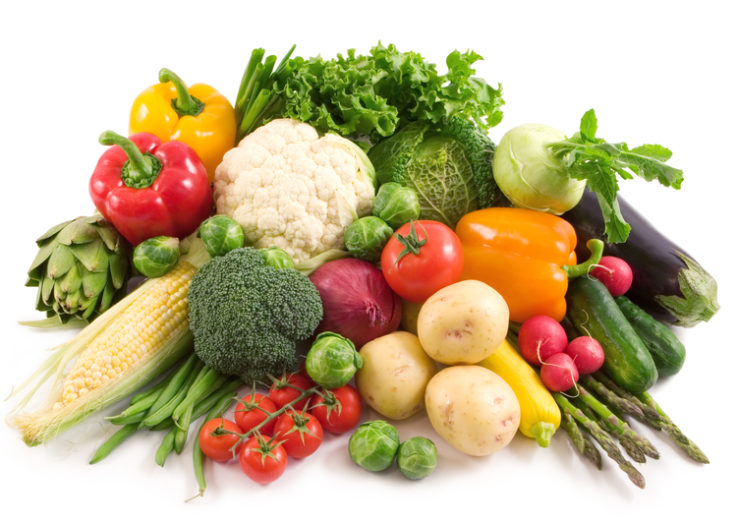Let’s be clear right from the start: Vegetables are good for you, and the vast majority of people don’t eat nearly enough. So, no matter where your favorite is on the best vegetables to eat list, it can be part a healthy diet and should neither be avoided nor scorned…as long as it isn’t deep-fried (yes, I’m talking about you, French fries, fried artichoke, fried pickles, onion rings, and anything else battered and deep-fried that you can think of), in processed form (that’s you, potato chips), or loaded with added sugars (hey, ketchup and carrot cake).
Most vegetables are good sources of vitamins, minerals, and fiber, packed with antioxidant phytonutrients (like polyphenols), and low in calories (i.e., low energy density). Yet there are some vegetables that offer the winning combination of having a higher nutrient-density combined with a lower energy-density compared to others. Here are some of the best vegetables to eat (you’ll want to ensure are on the menu).
The 10 Best Vegetables to Eat
1. Dark Leafy Greens
Whether you’re looking at spinach, kale, chard, mustard greens, collard greens, or others, you seriously can’t go wrong with leafy greens. These vegetables are some of the healthiest and can be enjoyed in so many different ways—even the stingiest palette can be satisfied. This is good news as at least two cups per day of leafy greens are recommended.
Spinach, for example, is good raw, blended into shakes or smoothies (it’s tasteless, I promise), or as part of countless dishes. A single cup of spinach contains only 7 calories yet provides over half the daily recommended amount of vitamin A and the entire recommended daily allotment of vitamin K, and spinach is also high in beta-carotene, vitamin C, lutein, and manganese.
Often referred to as the “ultimate super food,” kale provides vitamins A, C, and K (the recommended daily amount in just one cup) as well as antioxidants. It truly is one of the best vegetables to eat.
Swiss chard is another dark leafy green that’s low in calories and high in nutrients. Weighing in at only 7 calories, a cup provides a gram of fiber, a gram of protein, and vitamins A, C, and K, as well as manganese, magnesium, and a bolus of antioxidants. You’ll find two main varieties in the produce section: Rainbow or ones with white stems. Whichever version you try, you’ll also have a great source of lutein and zeaxanthin to support eye health.
Load up your plate with a cup of collard greens (a popular in the South) for 1 ½ grams of fiber, 1 gram of protein, and a quarter of the daily recommended amount of vitamin C. Like the other leafy greens, collard greens are also a great source of antioxidants, calcium, vitamin K, folate, and beta-carotene.
Another leafy green, which often ends up in the compost heap, is beet greens. This is a shame as they have a surprisingly delicious flavor and provide a good dose of vitamin K (nearly twice the daily requirement in a cup).
Other greens to throw into the mix are arugula, endive, watercress, romaine lettuce, and turnip greens.
If the “full grown” (i.e., more mature) greens are a bit too strong for your palette, give the “baby” versions a try as they tend to be sweeter and more tender yet provide a great dose of nutrition.
2. Cruciferous Vegetables
Among their many healthy and nutritious properties, cruciferous vegetables are loaded with sulfur-containing compounds (glucosinolate and sulforaphane), which have been shown in studies to help protect against a number of chronic diseases.
One of the most popular cruciferous vegetables, broccoli, is a great source of vitamin K (over 100% of the daily recommendation per 1-cup serving), vitamin C, folate, manganese, and potassium.
Move over kale, there’s a new best vegetable to eat: Cauliflower! It is so versatile, and it can made into everything from pizza crust to Buffalo wings to alfredo sauce. It is also a fantastic source of nutrients like vitamin C, vitamin K, fiber, and the powerful phytonutrient indole-3 carbinol (I3C).
Brussels sprouts, another member of the cruciferous family, also include a powerful antioxidant phytonutrient called kaempferol. They’re also loaded with nutrients including vitamins K, A, and C as well as folate, manganese, and potassium.
Cabbage is also chockful of nutrients. One cup will load you up with 85% of the daily recommendation for vitamin C and 2 grams of fiber, and what’s more, it’s a healthy source of anthocyanins—another powerful plant antioxidant.
Related to cabbage is another plant called kohlrabi, which is high in fiber (5 grams per cup), a good source of vitamin C, and rich in antioxidants.
3. Onions
Loaded with flavor and nutrition, onions provide vitamin C, B6, and manganese with just 64 calories per cup. Onions belong to the allium vegetables, which contain organosulfur compounds, powerful antioxidants. Other allium vegetables that are nutrient- and flavor-rich include leeks (which are high in fiber, potassium, vitamin C, and the antioxidant kaempferol), scallions, garlic, shallots, and chives.
4. Asparagus
One of the first signs of spring is an abundance of asparagus, which is rich in folate, selenium, vitamin K, thiamin, and riboflavin.
5. Carrots
Tasty, sweet, and a great crunchy snack, carrots provide 5 times the recommended daily intake of vitamin A in the form of the potent antioxidant beta-carotene along with vitamin C, vitamin K, and potassium.
6. Sweet Potatoes
4 grams of fiber, 2 grams of protein, plenty of beta-carotene (over 400% of the daily recommendation of vitamin A) and healthy doses of vitamins C and B6, potassium, and manganese all packed into a vibrant, sweet, and versatile vegetable.
7. Green Peas
Next entry on the best vegetables to eat list is green peas. These sweet bursts of goodness provide 9 grams of fiber, 9 grams of protein, the vitamins A, C, K, and the B vitamins folate, riboflavin, thiamin, and niacin in one cup. They also provide saponins, which are plant compounds known for their health benefits.
8. Beets
The leading source of dietary nitrates (known for positive effects on circulation), beets are also a good source of fiber and other nutrients.
9. Potatoes
While potatoes have been demonized over the years due to their high-carb content, they are also one of the most satiating foods you can find. Despite the long-stand myth, potatoes are not empty calories. Believe it or not, they have a very high nutrient-density, and compared to other starchy carbs, they have a low energy-density. This makes a plain potato one of the best vegetables to eat. But, people aren’t overeating plain, boiled potatoes; problems with potatoes arise as a result of preparation methods (e.g., deep frying) and additives (e.g., the ol’ “loaded” baked potato).
10. Celery
Known for its high water and fiber content, celery has long been called a zero- or even a negative-calorie food. While we’ll leave that debate for another day, celery provides plenty of flavor, makes a great snack (especially when combined with peanut butter or a Greek yogurt dip), and a somewhat unheralded source of nitrates and phytonutrients, including kaempferol and quercetin, which is a powerful antioxidant associated with a long list of health benefits such as supporting brain, immune, and heart health.
Other Best Vegetables to Eat
There are so many others that could easily fit on this list, such as:
- Alfalfa sprouts
- Artichokes
- Bamboo shoots
- Bok choy
- Chinese cabbage
- Cucumbers
- Dandelion greens
- Eggplant
- Fennel
- Green beans
- Jerusalem artichokes (sunchokes)
- Jicama
- Lettuces (e.g., romaine, red leaf, butter, etc.)
- Mushrooms
- Okra
- Peppers
- Radishes
- Rutabaga
- Tomatoes
- Tomatillos
- Turnips
- Winter squash
- Zucchini/Summer squash
What Vegetables Should You Avoid?
So, are there any vegetables you should avoid at all costs? You may be expecting the answer to be corn or potatoes, two foods that have a bad rap as higher-carb, starchy vegetables. Yet as we’ve discussed in past articles, both corn, particularly organic sweet corn, and white potatoes can have their place in many diets.
When looking at the best vegetables to eat, you do want to avoid those that are wilted and far from fresh, and you also would be wise to choose organic when possible to avoid pesticides, synthetic fertilizers, and GMOs. And for even more nutrition, reach for those that are local.
If you have the option, choose fresh first, then frozen, followed by canned. And if you do end up picking up canned vegetables, watch for excess salt, preservatives, and “flavor enhancers.” Also, avoid vegetables that have been cooked to death; you know, those that are soft, soggy, and void of most of their color and flavor. After all, that’s probably the reason many folks likely think they don’t like peas—they’ve never had them fresh and properly prepared.
And of course, as mentioned in the introduction, French fries with ketchup don’t count as your serving of vegetables nor do junk-food potato chips.
Best Vegetables to Eat: A Recap
At the end of the day, what’s most important is eating a colorful spectrum of vegetables and to give a wide variety of them a try. Vegetables are like fingerprints—they’re all different. While they may contain similar vitamins and minerals, different vegetables provide unique phytonutrients and even an array of different fibers. Eating fresh, local, seasonal produce is also an excellent rule of thumb.
A fun game is to see how many different vegetables (and fruits) you can eat in a week or month and then see if you can beat that the following week or month. Another game is to just try one new vegetable each week. You never know: You might find a new favorite or fall in love again with one that hasn’t been part of your menu lately.









